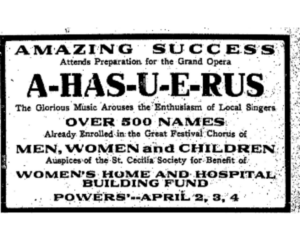Follow the Money
The Brown Home and the Lawsuit that Created a Women’s Hospital
By Diana Barrett
Brown Home entered my life when my mother became a Brown Home lady in March of 2001 after suffering a stroke. Why were the letters WH&H embedded in the façade of a building named Brown Home? I learned that they stood for the Woman’s Home and Hospital, its earlier name, and that Brown Home had been built with money obtained as the result of a notorious trial.
In 1846 a few women met in the “Prospect Hill” schoolhouse to start a society for benevolent purposes. During the following years the society evolved into the Woman’s Home which cared for a few women at a time in various rented or donated locations.
By 1891 the Board of Managers of the Woman’s Home realized the importance of owning a building and maintaining a permanent location. They purchased a fourteen-room building at 69 Bostwick Avenue for $6000 where they remained until 1916.
In June of 1891 James H. (Jockey) Brown died a few blocks away at 126 S. Ionia. He left a large estate valued at $200,000—most of it earned by trading in real estate and lending money. A widower, he left his estate to one daughter, Margaret Haines, with only a tiny provision for his other daughter, Alice Hayden. Alice contested the will.
Both sides enlisted the cream of the city’s legal profession; four attorneys for Alice, including the mayor, E. F. Uhl, and six for Margaret. The trial began mid-February of 1892. The court heard and the papers reported (in depth) all the dirty linen of the Brown family, both true and imagined. Alice accused Margaret of poisoning her father’s mind by telling him that she was not his daughter. Friends and relatives testified about Mrs. Brown’s relationship with her doctor who Margaret had supposedly claimed was the real father of Alice.
The jury quickly reached a verdict on March 12. The GR Daily Eagle reported, “At the verdict the crowd of spectators broke into tumultuous applause. Men and women cheered or threw their hats in the air . . . the reception of the result was one of the most dramatic scenes ever witnessed at the trial of a civil case in this city.”
Alice won. Margaret appealed the case to the Michigan Supreme Court. She said she’d rather give all the money to the lawyers than give Alice a penny. In April of 1893 the higher court upheld the earlier verdict that the sisters should share equally.
Alice left her estate to the Woman’s Home for a new building IF they would name it after her father. They did, and Brown home at 1425 E. Fulton was completed in 1916. How ironic that Alice, considered so fun-loving and profligate that her father denied her in his will, kept his name alive in a way that brought comfort to so many women for almost one hundred years. Sadly, Brown Home closed its doors in November of 2002.
When I read the newspaper reports of the trial, I imagined myself sitting among those women who came to court everyday to support Alice Hayden. I, too, would have cheered and thrown my hat in the air.
Sources
This article can also be found in the Winter 2007 GGRWHC Newsletter.

